Illinois Crop Update – June 20, 2025
Steve Brand – Commercial Agriculture Specialist
Dekalb County
Soil Conditions: Mildly Dry (soil is drier than normal, plant growth may have slowed)
The past couple of weeks have been exceptionally dry for Northern Illinois. We have had a few sporadic rain events with rainfall totals being very isolated and regional from pop up severe storms. With the rain we received this past week including Wednesday 6/18 we have moved towards a more normal rain total on the season, which was needed. Much of I-80 and north has moved between D0 and D1, which is a slight improvement from some localized D2 droughts. Temperatures are jumping, and we are expecting some hot and humid weather in the weeks to come with more normalized temperatures for this time of year. Overall, we had a great week for Growth Degree Units (GDU), and for the year, Dekalb area is up to 740 growth units as of 6/18.
Corn, for the most part, is very drought stressed and showing signs in the form of pineapple corn. Skinny, withered plants across most fields. The crops are varying widely in growth stage with some fields at V4 pushing into V5 about 15 inches tall, with others at strong and healthy V7 plants 2 1/2 to 3 feet tall. The localized rain from significant pop-up storms the past week are to thank, and many fields are either the have or have-nots when it has come to rainfall. The two corn pictures I have posted below are from fields about 2 miles apart in Dekalb County, really showing how isolated some of these rain events have been. The rain on 6/18 brought an average of 0.5″ to over 1″ depending on how far south you are through the Joliet region.
Soybeans are still stunted a slight bit from the drought but overall appear to be healthy. Fields are ranging between 3 to 5 trifoliates, and the added moisture will continue to push more growth. I have not seen any early season diseases but have noticed a slight bit of insect damage across most fields, but nothing to write home about. Overall, fields have good stands and good vigor and should grow out of the stunting.
I did not have a chance to get into any wheat fields this week. The few I drove past and got a quick look at seem to be in Feekes 11 around dough stage and are ripening nicely. I will hopefully have scouted for any late season diseases by next week as well. With the increased growth units this week and the forecast calling for hotter temperatures, the wheat should start to ripen nicely for an early July harvest.
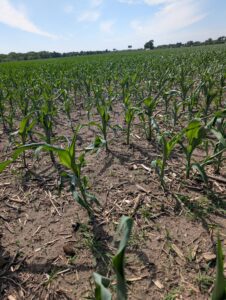
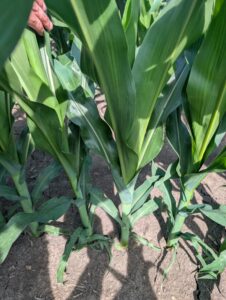
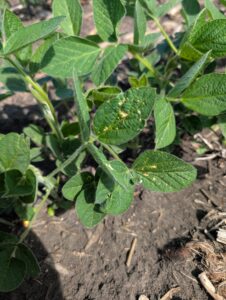
Russ Higgins – Commercial Agriculture Educator
Grundy County
Soil Conditions: Mildly Wet (soil is wetter than normal, local vegetation is healthy)
Recent precipitation in Northeast Illinois ranged from 1+ to over 4 inches of accumulated rainfall. Some edge of field wind damage noted in corn fields. Earliest planted soy is starting to flower, entering the reproductive stage of the crop. The most mature corn has reached or is near V10 to V11. A reminder, if scouting mature corn, lower leaves will start to drop. In these cases, the first measurable internodal space is generally between the 5th and 6th node. Recognizing this provides a starting point at V6 when staging older corn. Depending upon corn hybrids, expect between 15 to 20 leaves prior to tassel emergence. This is an important period of rapid growth as the corn plant creates leaves and stalk growth to provide photosynthate for the ear and developing kernels. I’m a strong advocate of spending time on the ground scouting fields, recognizing any manageable issues that may arise. That said, I can also appreciate drone imagery to provide different perspectives on the developing crop. I have had mixed experiences with drones, but I have to admit the newer generation drones are more user friendly. For those with access, collecting aerial images as the soy and corn crop transition from vegetative to reproductive stages can provide insight during end of season crop evaluations.
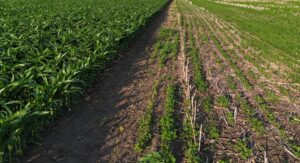
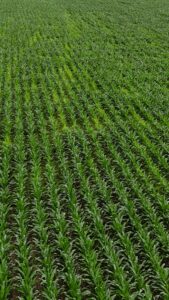
Reagan Tibbs – Commercial Agriculture Educator
Logan County
Soil Conditions: Moderately Wet (soil is damp, standing water may be present in low areas, water bodies are full)
Crop growth is starting to vary across Logan County. Corn around the county looks very healthy, with many fields well above knee-high. Growth stages range between V4 and V6. Soybean growth is more varied. Some fields look healthy and are in the V4-V6 stage. However, some fields are lagging, with some in the V2 or V3 stage. With beneficial rains on 6/18 and more hot temperatures on the way, it will be interesting to see how these fields progress over the next week.
Nick Seiter – Extension Field Crops Entomologist
Champaign County
I had the opportunity to visit a field with probably the worst grape colaspis injury I have seen earlier this week – note the P deficiency symptoms on lower leaves of many of the plants, and the aggregated nature of the injured plants. Usually, we see this in fairly isolated areas in a field (often at the high points), and several nearby fields had this more limited injury. But in this particular case, much of the field was affected. When you see this kind of injury above ground, dig up the plant and see if you can find the larvae (which resemble tiny white grubs) – some plants in this field had as many as 8 or 9 larvae on them, and we found at least one pupa. These should cycle out into adulthood soon.
Wednesday’s winds revealed some plots in my rootworm evaluation field have pretty severe injury – feeding has been going on long enough in central IL that you should be able to get a preliminary idea of how much (if any) rootworm pressure you have. Over the last few years, we have had few rootworm problems in central/southern Illinois. Most of our problem fields have been in northern/northwestern IL in areas with a lot of corn after corn – it will probably be a week or so before feeding injury will reveal itself there due to the slower temperature accumulation. Remember, if you are interested in monitoring rootworm adults as part of our regional monitoring program please, reach out to my email: nseiter@illinois.edu.

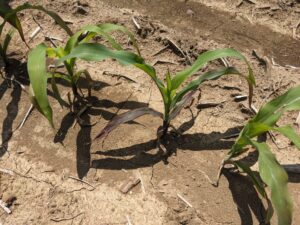
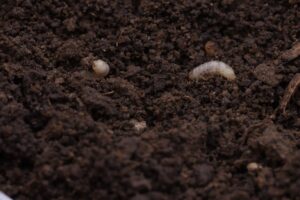
Talon Becker – Commercial Agriculture Specialist
Vermilion County
Soil Conditions: Mildly Wet (soil is wetter than normal, local vegetation is healthy)
After the strong storms that passed through the region Wednesday (6/18), most fields in northern Vermilion County are saturated with a little standing water in low lying areas and compacted headlands. The storms also brought strong winds, but fortunately, the damage to crops seems to be minimal in that part of the county. Most corn in the area was leaning, but there were only a couple areas of fields I saw where the crop was nearly flat. The affected corn was on the more advanced end of the range of crop growth in the region, which is around the V8-V10 growth stages. However, I saw minimal green snap, so much of that corn that is currently horizontal will likely recover, albeit with a goosenecked stalk. Later planted corn, generally in the V3-V4 range, was affected little by the winds. Soybeans ranged in growth stage from V1/V2 to R1, with some earlier maturity soybeans starting to open their first flowers. Weed control in both corn and soybeans was mixed, with the wet conditions likely contributing to an inability for farmers to get timely post-emergence herbicide applications completed. I found a couple wheat fields during my survey, both of which were in the Feekes 11.2 growth stage with kernel starches a “soft dough” consistency.
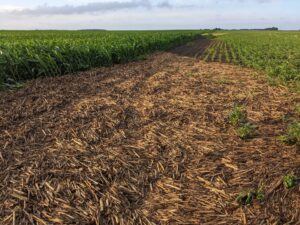

Dane Hunter – Commercial Agricultural Specialist
Marion County
Soil Conditions: Moderately Wet (soil is damp, standing water may be present in low areas, water bodies are full)
Still wet. We had one brief window last week in which a little more planting took place, followed by a few more inches of rain. Most fields are planted, but not all. Still 5-10% unplanted through this region. Temps in the high 90s slated for the next several days, so maybe that’ll dry things up enough to finish the first crop. Hot weather ought to also help get the wheat crop down the home stretch. The grain is almost dry, but fields are still wet. Hopefully there will be enough evaporation to keep us from rutting up fields to get the wheat out.
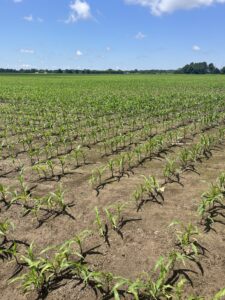
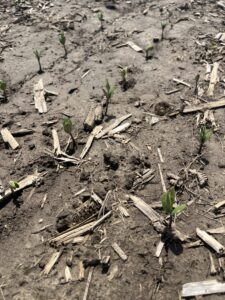
Figure 12: Soybeans planted on June 12th that are emerging.
Alt text: Soybeans planted on June 12th that are emerging.





